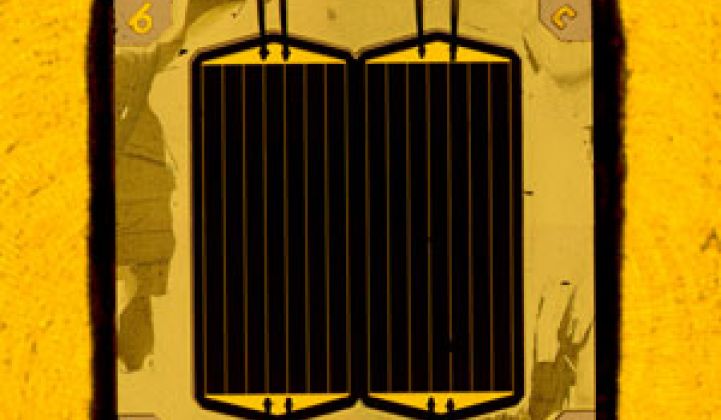A German research institute has squeezed 41.1 percent out of a solar cell built with highly efficient materials, though whether the expensive technology could find mass-market adoption remains to be seen.
The Fraunhofer Institute for Solar Energy Systems announced its achievement Friday and said it is working with Azure Power and Concentrix Solar to commercialize the research.
Scientists at Fraunhofer built the three-layer cell using gallium-indium-phosphide, gallium-indium-arsenide and germanium. The cell was able to convert 41.1 percent of the sunlight that hits it when researchers concentrate the sunlight 454 times, Fraunhofer said.
Using concentrated sunlight is key to make this project more than just a quest for high efficiencies. Gallium arsenide and other semiconductor compounds in the same family are expensive compared with silicon, which is less efficient but is much cheaper. Most of the solar cells made for the market today use silicon. Those cells are then assembled into panels for installation.
Gallium-arsenide solar cells have been used to run satellites and other space crafts, government-funded projects that don't put a premium on using the cheapest materials possible.
Cost, of course, is a much bigger deal for solar companies competing to build power plants or sell solar panels to consumers. By using concentrated sunlight, which can be done by with mirrors and lenses, a solar panel wouldn't need as much gallium-arsenide cells to generate ample electricity. This is the sales pitch from a growing number of companies in the emerging concentrating solar sector.
Concentrix is one of the better-known concentrating solar companies and a Fraunhofer spinoff. Last fall, the company opened a factory to make concentrating solar panels. It has an initial production capacity of 25 megawatts per year, but could expand to up to 100 megawatts per year.
Concentrix's best solar panel has an average efficiency of 27.2 percent, the company said. Solar cells typically lose some of their efficiencies once they are assembled into a panel, so the efficiency numbers for solar panels are lower than the figures for the cells.
SolFocus, based in Mountain View, Calif., is another concentrating solar company that has attracted a lot of attention. The startup recently raised private equity to commercialize its technology (see SolFocus Scores $47.5M to Peddle Concentrating Solar Technology and SolFocus Boosts Solar Efficiency). SolFocus designs its own optics for concentrating the sun but buys solar cells from companies such as Emcore.
There are other startups focusing on developing gallium arsenide cells. Wakonda Technologies, based in Medford, Mass., raised $9.5 million from venture capitalists last summer to do just that.
The cell touted by Fraunhofer Friday is a metamorphic triple-junction solar cell, so called because it has three layers. This idea of using three layers of materials to get the most out of the sun isn't new. Many research institutes and private businesses have been developing three-layered cells for years, and the key is to figure out which materials to use, how to make them work well together and whether they can be mass-produced at competitive costs.
In fact, companies already hare selling them, including Spectrolab in Sylmar, Calif.
Fraunhofer's researchers were able to devise ways to improve a triple-junction cell's performance by localizing the defects that can happen when you put three layers of different semiconducting compounds together. In other words, the scientists were able to keep the part of the solar cell that was crucial for electricity generation free of defects.
Last year, the National Renewable Energy Laboratory, run by the U.S. Department of Energy, announced it had created a triple-junction cell with 40.8 percent efficiency (see Federal Lab Breaks Efficiency Record with ‘Mismatched' Solar Cell).
NREL researchers used a different semiconductor concoction than the one used by Fraunhofer. NREL's cell was consisted of two layers of gallium indium arsenic and one layer of gallium indium phosphorus (see this graphic).



